The ASUS PA328Q has one of the best onscreen implementations we have seen. The 5 way OSD joystick at the top of the I/O panel can be used to move selections in all directions, and can be pushed in for activation. You rarely need to use any of the other buttons for any settings.
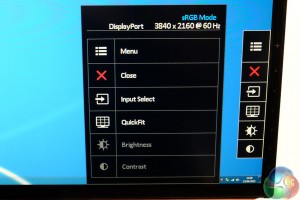
The smaller, main interface panel gives you a breakdown of the various sections, along with the current running resolution and refresh rate.
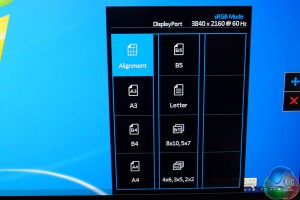
There is an onscreen system to view the actual size of documents – useful for specific tasks.
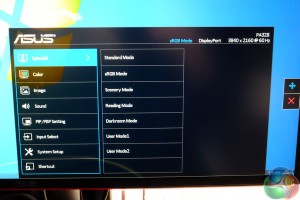
The Splendid menu system allows adjustment through various preset options. Surprisingly, some of the modes are very limited. sRGB and Standard modes wouldn't allow any adjustments to any of the picture settings such as contrast or brightness, which was slightly irritating. Scenery Mode actually proved the most useful in our testing although it disabled the ‘Uniformity Compensation' feature completely, but more on this later.
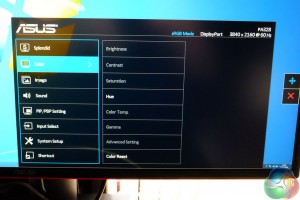
The color memu changes depending on the Splendid mode you have selected beforehand. In sRGB mode, only Hue is available – all the rest are grayed out.
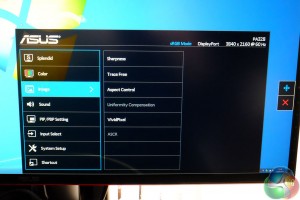
The image panel is useful for adjusting specific IQ, but again some of them will be grayed out depending on the mode you are using.
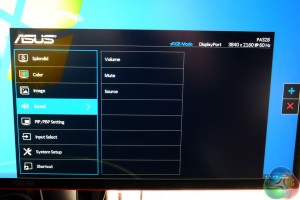
The sound quality from the Asus PA328Q is nothing to write home about, but you can adjust volume, source and mute settings in here.
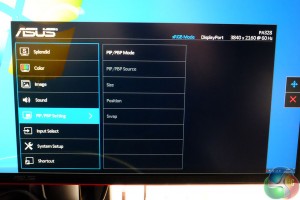
The screen offers a variety of Picture In Picture settings.
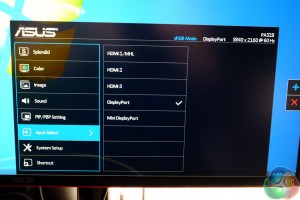
There are a total of five input options, 2x HDMI (one with MHL support), DisplayPort and Mini Displayport.
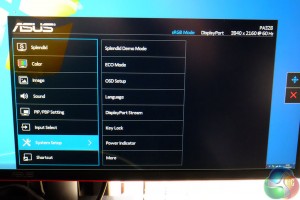
The System Setup menu offers adjustments for power, Key Lock, OSD, and ECO modes.
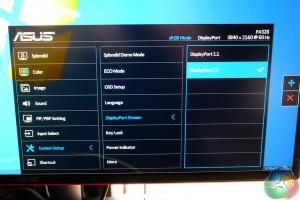
There are also adjustments for DisplayPort 1.1 and 1.2 modes to offer 60hz refresh.
Tags 4K IPS monitor Asus PA328Q Asus PA328Q ProArt Monitor Asus PA328Q ProArt Monitor Review Asus PA328Q review best 4k panel best IPS panel best ultra hd 4k monitor Review
Check Also
Reader Survey 2025 – Win one of THREE Sapphire RX 9070 XT graphics cards!
The KitGuru Reader Survey helps us understand what kind of products you are keen to learn more about in 2025/2026. It takes less than 5 mins to complete and it really helps us to target our editorial efforts. As a thank you to those of you who participate, we are offering the chance for you to win one of THREE brand new Sapphire RX 9070 XT graphic cards!
 KitGuru KitGuru.net – Tech News | Hardware News | Hardware Reviews | IOS | Mobile | Gaming | Graphics Cards
KitGuru KitGuru.net – Tech News | Hardware News | Hardware Reviews | IOS | Mobile | Gaming | Graphics Cards



It’s actually only twice the pixel density of a 1080p monitor of the same size.
You’re wrong and here’s why…
32″ is the diagonal measurement so effectively, 27.89″ × 15.69″
= 437.6in² 16:9
1080p = 68.84 PPI
2160p = 137.68 PPI
But wait, that’s only double? Wrong, this is the misinterpretation of pixel
density. If we were strictly talking about a straight line, then yes this would
be correct. However, because we are using a 2d plane for our viewing pleasure
it is in reality like this.
1080p = 4739 PPI²
2160p = 18956 PPI²
That’s right, the pixel density is correctly 4x that of 1080p. =D
The styling looks similar to the ROG Swift, nice! 🙂
◔❧❧◔❧❧◔I RECEIVED FIRST DRAFT OF $13000!@ak6:
,
➨➨➨➨https://QuickerAdvicehina.biz/learner/kits….
2X lineal density
4X areal density
People misunderstand how crucial it is to calculate the correct pixel density and use the linear form since the numbers are smaller making them easier to pick up on. But, we don’t just view screen in a straight line. Also, they’re not equally the same PPI Vertically as they are Horizontally. They differ slightly, but not by much to write home about.
“Factory pre-calibrated, industry-leading color accuracy with 100% sRGB and Rec. 709 color space support.”
its NOT UHD-1 Rec. 2020 real color space compliant so why would any consumer care to spend any money here when UHD-1/UHD-2 have their “basic parameter set” is defined by the “ITU BT.2020 standard” 10bit/12bit real colourspace, and not the antiquated Rec. 709 pseudo color space.
https://tech.ebu.ch/docs/events/webinar049_BeyondHD-update/hoffmann_beyondHD_update.pdf
http://www.bbc.co.uk/rd/blog/2013/06/defining-the-future-of-television
Defining the Future of Television
Posted by Andrew Cotton on 19 June 2013
…For those who’re not familiar with UHDTV its basic parameter set is defined by the ITU BT.2020 standard. The standard defines two UHDTV profiles – what’s commonly called UHD-1 at 3840×2160 pixels and UHD-2 at 7680×4320 pixels. The UHD-2 format was used for last year’s joint NHK/BBC public demonstrations of Super Hi-Vision during the London 2012 Olympics…..
Correct or to put it more simply:
HD 1920 x 1080p = 2,073,600 pixels displayed
UHD 3840 x 2160 = 8,294,400 pixels displayed
UHD is exactly 4 times HD (4 x 2,073,600 = 8,294,400) pixels
Not one of your better reviews guys. There is little mention of the HDMI 2.0 input which is a first on a monitor. Does it support chroma 444 across all inputs at 60hz 4k etc. We need details.